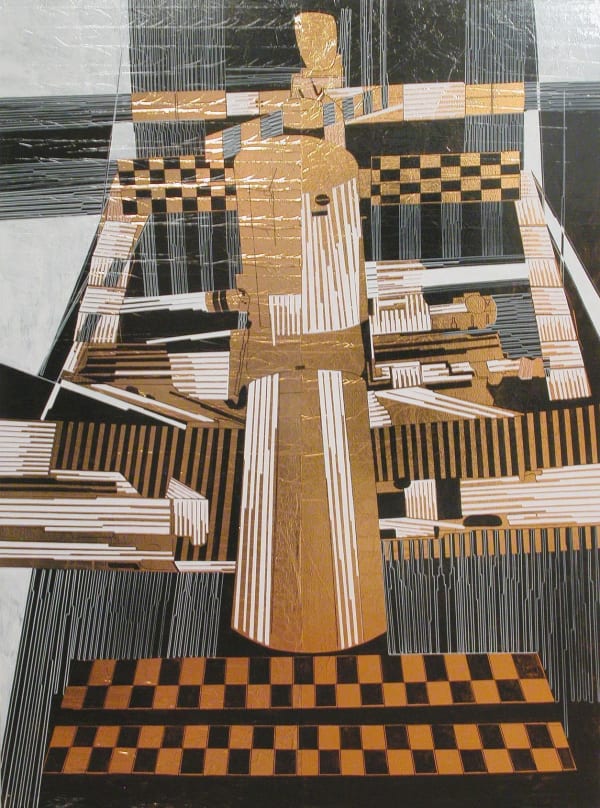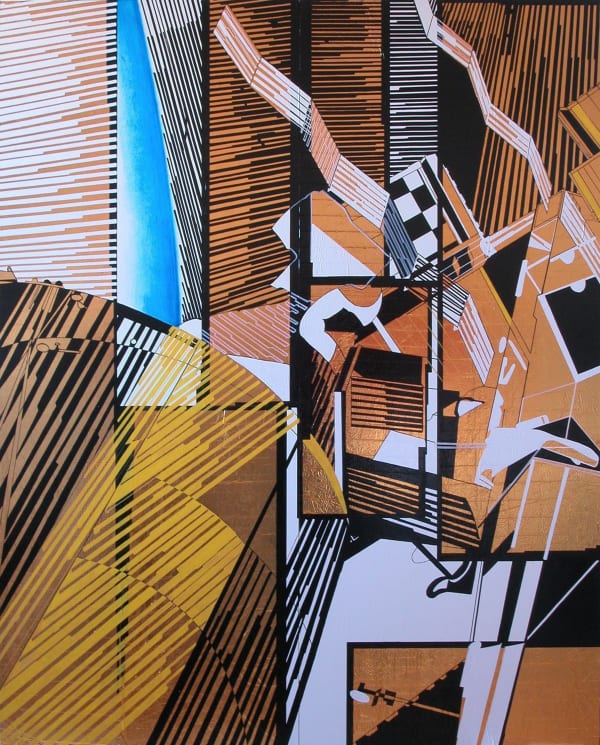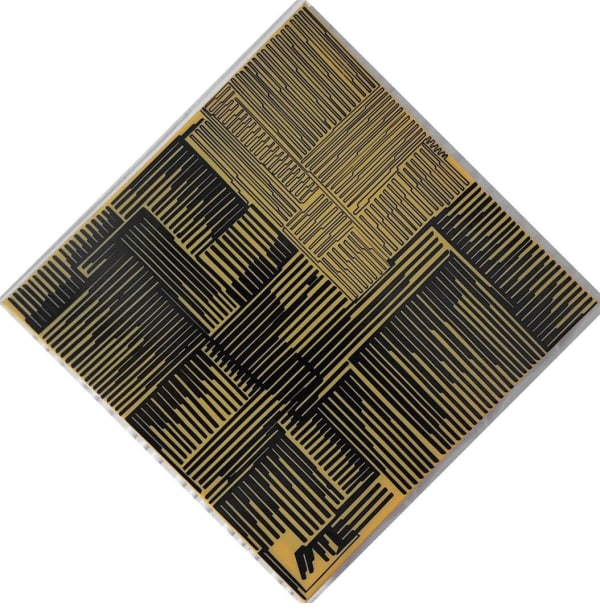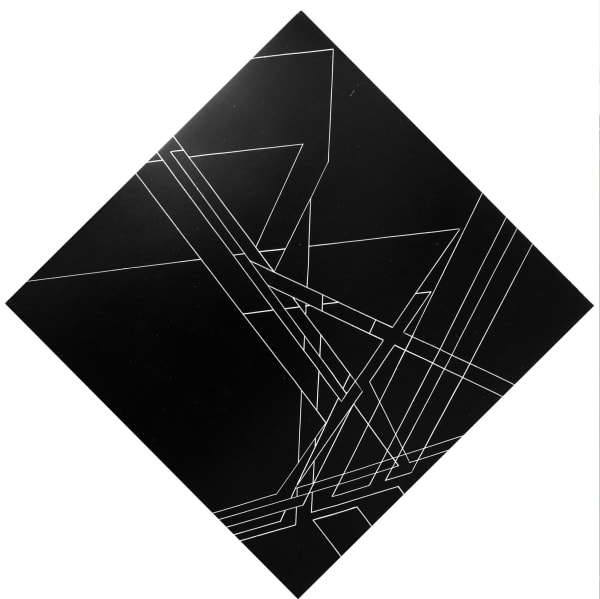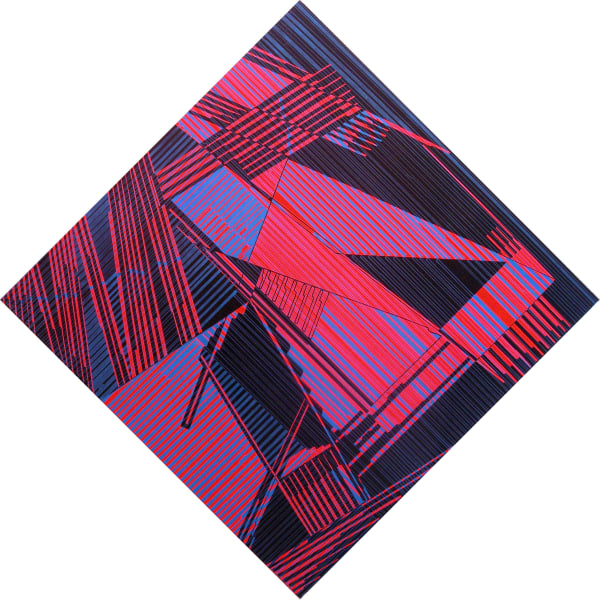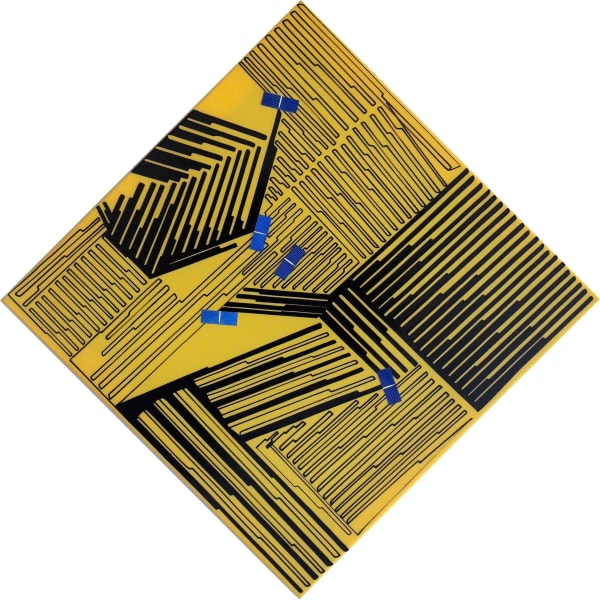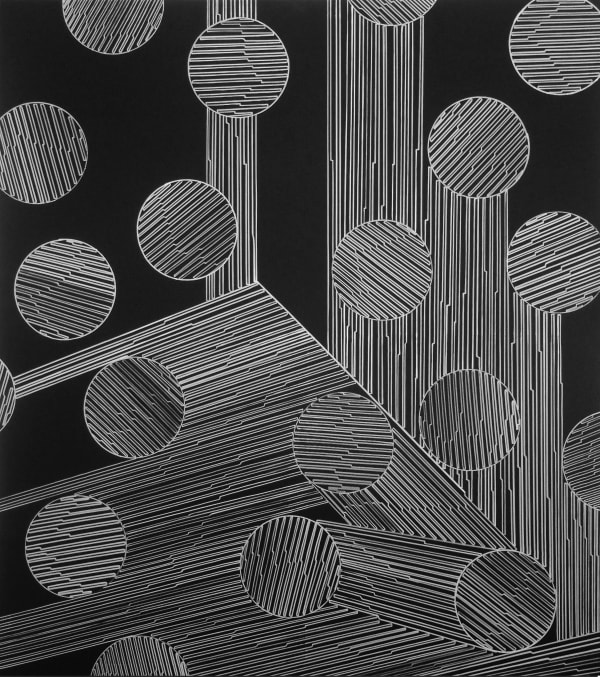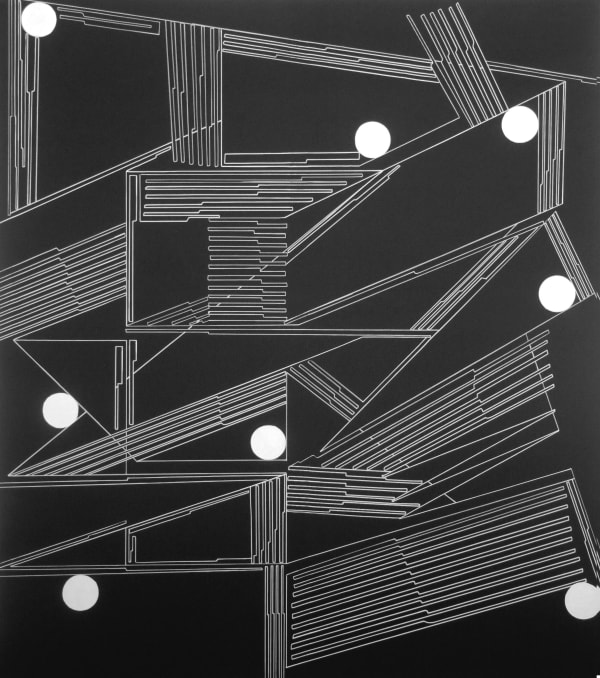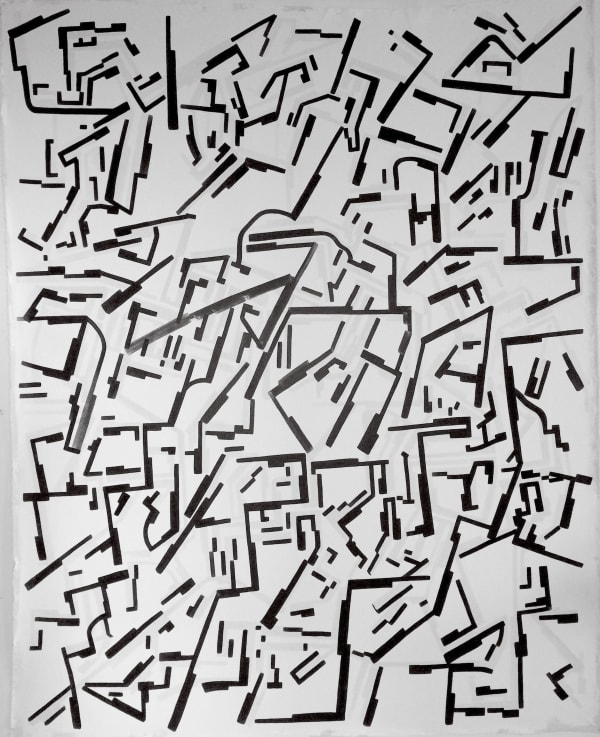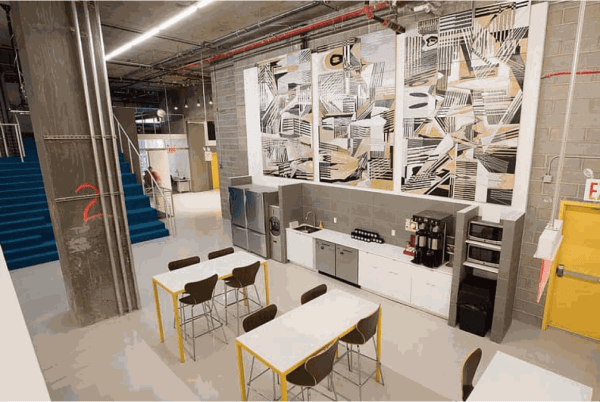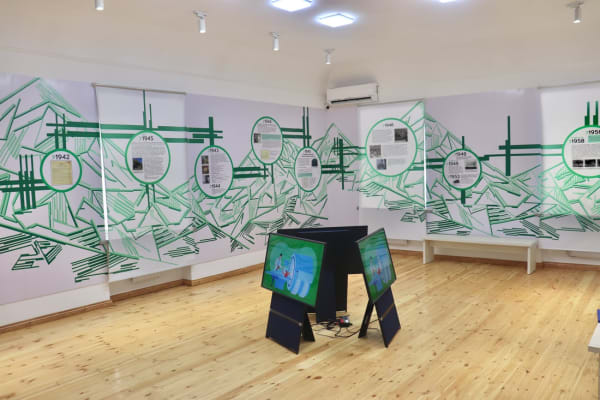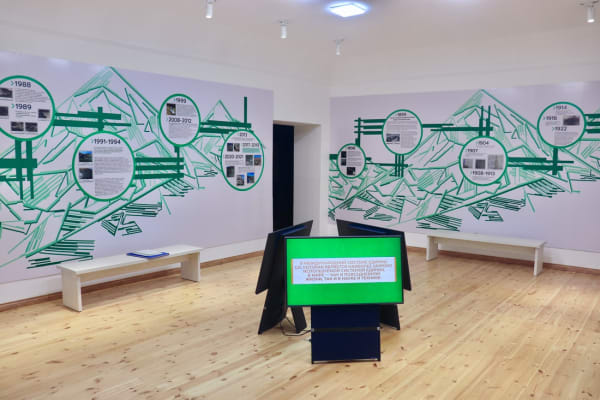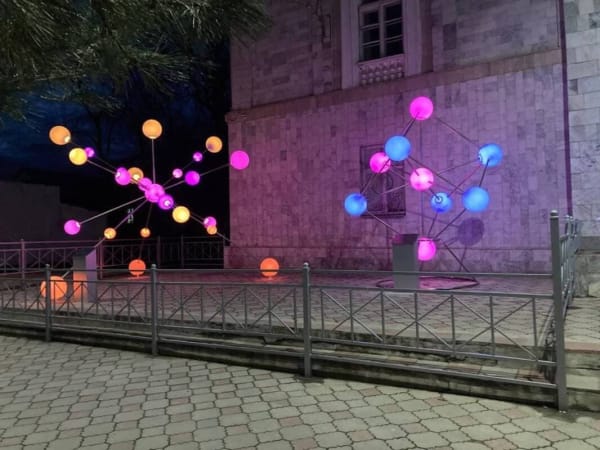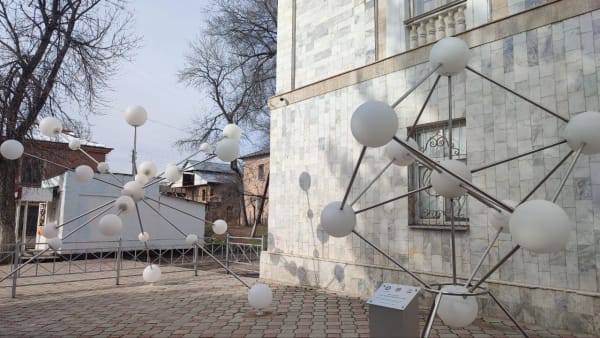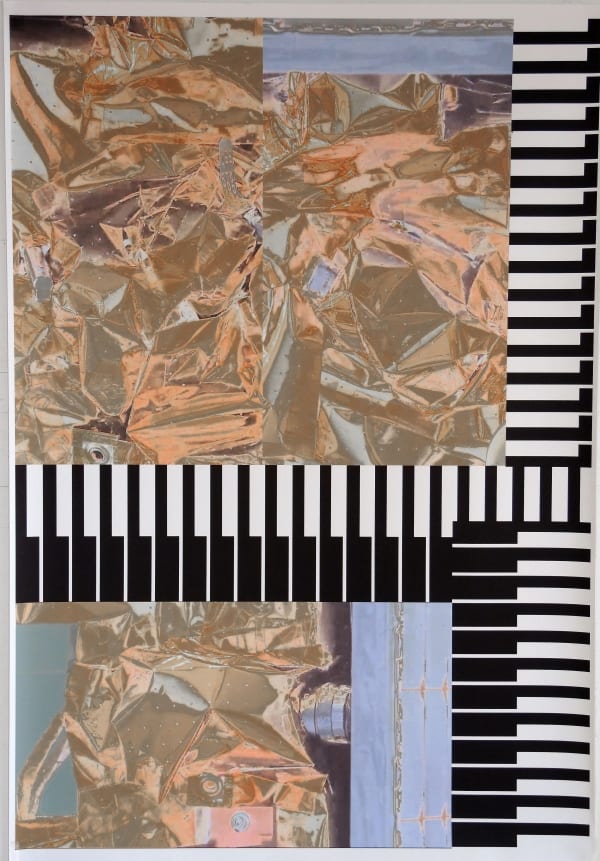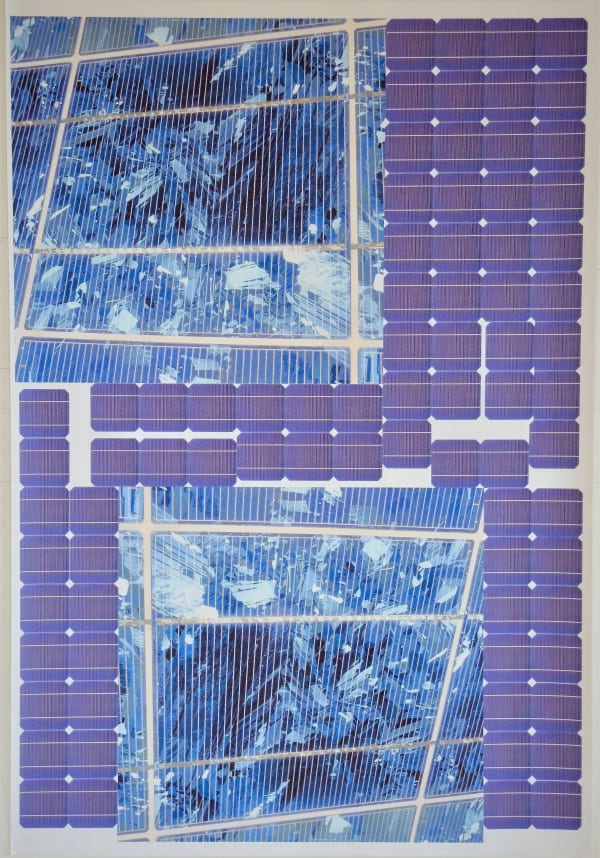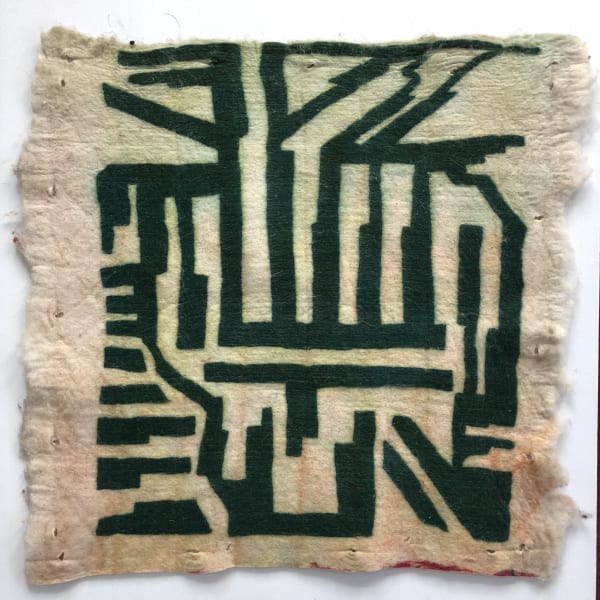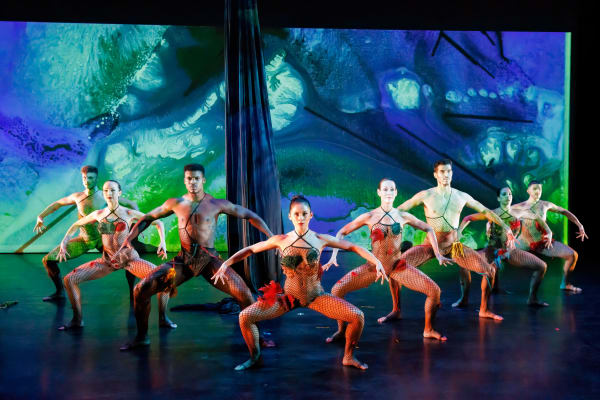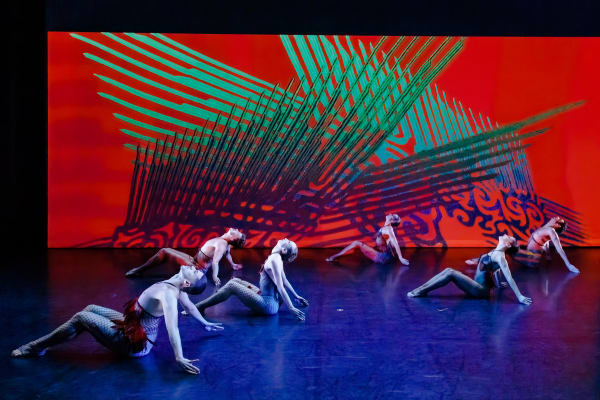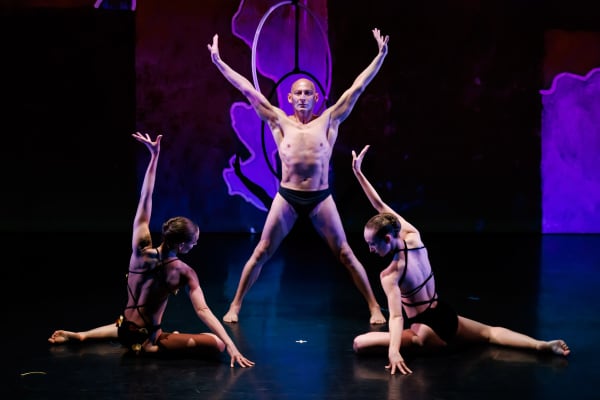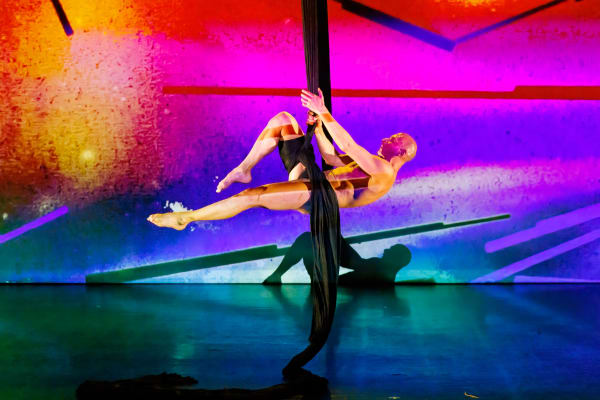-

Vargas-Suarez Universal in his Bishkek, Kyrgyzstan Studio. Photographed by Louise Amelie Studio, Berlin.
-

Vargas-Suarez Universal in his Brooklyn, New York studio, 2016. Photographed by Kevin W. Condon
-

Vargas-Suarez Universal, Space Station: Ludgate, Oil pastel on electro-static transfer mylar print, 2005
-
ARTERIAL SYSTEMS
2004Inspired by his Mini-Med School coursework at the Mount Sinai School of Medicine, Vargas-Suarez Universal reimagined the New York City subway system as if it were a human circulatory system. He recalled the metaphor in a 2005 interview with BOMB Magazine: “with Manhattan being an island, I thought about the island as a body and the subway system as this arterial lifeline that carries the energy particles that make it function.” This vision led him to produce the Arterial Systems series, for which he collected subway service change notices (which inform riders when trains will be canceled, rerouted, or under construction) and obscured the printed text with dizzying vector drawings.
.
-
Dieu Donné Paper Mill, Inc. Workspace Program
As one of four residents in the 2007-08 Dieu Donné's Workspace Program, Vargas-Suarez Universal continued to develop his artistic technique and explore new materials while experimenting in a collaborative setting. While learning the hand papermaking process, he realized that he had “always thought of paper as a sort of landscape.”[1] Following his fascination with diagrams and discovery, Vargas-Suarez used a syringe to inject blue pigment into a topographical map of Pennsylvania and called the final work Terraformation Triptych.
[1] Vargas-Suarez Universal, “Vargas-Suarez Universal,” Dieu Donné, November 2008, https://www.dieudonne.org/vargassuarez-universal
-
Back at his own studio, Vargas-Suarez had started working with what he understood as “non-art materials”,[1] such as discarded satellite dishes, thermal space blankets, and video projector screens. He felt determined to incorporate one of these materials into his work at Dieu Donné, and despite some difficulty, with the help of technical collaborator Steve Orlando, Vargas-Suarez successfully “sandwiched the thermal blankets between layered sheets of cotton and abaca paper by way of cutout ‘windows.’” This major breakthrough, now one of many, marked only the beginning for Vargas-Suarez, whose work continued to grow in complexity and depth.
[1] Vargas-Suarez Universal, “Vargas-Suarez Universal,” Dieu Donné, November 2008, https://www.dieudonne.org/vargassuarez-universal
-
Transition to Painting
Virus AmericanusA long-time admirer of the Hudson River School, Vargas-Suarez Universal relied on imagery from cameras, satellites, and telescopes to paint abstract celestial landscapes. His earliest paintings focused on the geography and geological history of Mars. Across almost twenty years of painting, Vargas-Suarez has consistently found new ways of working with and visualizing journeys through space.
At the start of the new millennium and in the wake of the dotcom bubble, Vargas-Suarez began his Virus Americanus series reflecting on the nature of networks, computer viruses, and freedom of movement. The series title, Latin for ‘American virus,’ imitates the formal binomial nomenclature system for naming and classifying organisms. Vargas-Suarez completed part of the series on wood panels to highlight the many ways that humans themselves can act as viruses in both society and nature. Taking on new meaning after the September 11 attacks and COVID-19 pandemic, the Virus Americanus series is both timeless and ever-evolving:
[I] started the series right before 9/11, Summer of 2000, continued into 03-04. Virus americanus are the latin words for "virus" and "American." [I was thinking about] Networks, architecture, how we move through the world. “What it means to be from the United States, what it means to be a foreigner from the U.S.
'Foreign body in a body' (virus) scientific nomenclature.
Then 9/11 happened and emphasized what it means to be foreign, [to be] a threat. When painting on wood panels… 'Organic natural material from landscape that withstands time…' Trees as nature’s architecture. Started noticing wood grain as 'organic biomorphic forms within wood grain'
Vargas-Suarez Universal
-
El Dorado
2009Эльдорадо, Russian for ‘El Dorado’ or ‘The Gilded One,’ refers to both the legendary king who covered himself in gold and the lost city over which he reigned. For centuries, the story of El Dorado drew Spanish conquistadors and European explorers to the Americas to search far and wide for this mythical city of gold. Vargas-Suarez’s Эльдорадо series represents yet another material breakthrough for the artist. For these paintings, Vargas-Suarez covered large panels with space blankets which were originally invented by NASA to protect and insulate their spacecrafts. Vargas-Suarez then painted over these amber-gold blankets with his vector shapes and space shuttle imagery. When exhibiting this series, Vargas-Suarez would add site-specific, antenna-like wall drawings so that the paintings resembled satellites and spacecrafts floating in the cosmos.
[The series] refers to the mythological land of infinite wealth– a legend extremely popular in the seventeenth century.
The installation combined painting and wall drawing that echos satellites and space crafts; with lines extending onto walls, continue lines from paintings.
Vargas-Suarez Universal
-
Spacewalks-EVAs
Vargas-Suarez Universal has spent many nights studying how people live and work in space. Sometimes working until two, three, and four in the morning, Vargas-Suarez regularly projected livestream broadcasts of astronauts working outside the International Space Station onto a wall in his studio. Using enamel paint markers, Vargas-Suarez would trace the outline of structures and spacesuits as they moved through space. He then used these contours to create his Expedition and Extra Vehicular Activity (EVA) paintings. Extravehicular activity is the official term to describe activities performed by space-suited astronauts outside of their spacecrafts.[1] Vargas-Suarez completed these spacewalk paintings in aluminum oil enamel on polypropylene canvas, materials that are typically used in spacecraft assembly and manufacturing. By capturing the real-time movement of astronauts in space, Vargas-Suarez translates scientific information to an aesthetic context.
[1] “Extravehicular Activities,” NASA, https://www.nasa.gov/content/extravehicular-activities
NASA Astronaut, Chris Cassidy (USA) and European Space Agency (ESA) astronaut, Luca Parmitano (ITA) worked outside the International Space Station moving at 17,500 mph at an altitude of 220 statute miles for 6 hours and 7 minutes to do maintenance work on the orbiting station. The linear drawings are live tracings of choreographed movements and on screen graphics during the televised spacewalk. The paint is aluminum oil enamel, also used to paint spacecraft, and painted on polypropylene canvas, used to cover electrical cables onboard spacecrafts, satellites and rocket hardware.
Vargas-Suarez Universal
-
Production images, SPACEWALKS
2007 - present -
-
Space Junk Diamonds
2012-2018While maintaining explicit reference to space age technology, Vargas-Suarez spent the early 2010s cultivating his signature vector style and worked in as many colors, orientations, and combinations imaginable. Entry Points refers to the act of entering and exiting atmospheres. Spacecraft navigators must locate and approach precise atmospheric ‘entry points’ to safely land on Mars or return to Earth. This work, along with the Thermal Vectors paintings, feature solar cells. Solar cells convert sunlight to electricity and are the building blocks of solar panels. Another group of paintings, Jettison Re-Entry, is named after the debris, or ‘space junk,’ that falls from spacecrafts and gets left behind in Earth’s orbit. Meanwhile, Telemetry refers to the process of gathering and transmitting data from spacecrafts and satellites back to mission controls on the ground, relay antennas and the International Space Station. Many of these pure vector paintings are considered part of the umbrella Space Junk Diamonds series.
-
-

Vargas Suarez Universal, Thermal Vectors, Oil enamel on polypropylene canvas, 24 x24 in
-

Vargas-Suarez Universal, Telemetry, Oil enamel on canvas, 30 x 30 in, 2012
-

Vargas-Suarez Universal, Entry Points, Solar cells on polypropylene canvas, 30 x 30 in
-

Vargas-Suarez Universal, Telementry Re-Entry, Oil enamel on canvas, 30x 30 in, 2012
-

Vargas-Suarez Univeral, Jettison Re-Entry VII, Oil enamel on canvas, 30 x 30 in, 2012
-

Vargas-Suarez Universal, Jettison Re-Entry VI, Oil Enamel on canvas, 30 x 30 inches, 2012
-

Vargas-Suarez Universal, Thermal Vectors V, Oil Enamel and solar cells on polypropylene canvas, 24x24 in, 2013
-

Vargas-Suarez Universal, Jettison Re-Entry, Oil Enamel on canvas, 24 x24 in, 2012
-
-
Vargas-Suarez Universal: Artist Profile
Barbora Bereznakova Watch on Vimeo -
Paintings 2004-Present
-

Vargas-Suarez Universal, Space Station Terra, 2004
-

Vargas-Suarez Universal, Space Station Docking Point, 2008
-

Vargas-Suarez Universal, 5 Sputniks, 2013
-

Vargas-Suarez Universal, Vector Array, 2013
-
-
MURALS, INSTALLATIONS, AND PUBLIC ART
In 2013, Columbia University’s Ira D. Wallach Gallery and Miller Theatre invited Vargas-Suarez Universal to be the first artist to transform the Miller Theatre lobby with a site-specific installation. The inaugural commission was the first-ever collaboration between the two campus arts institutions and led to the now-annual exhibition series in the Miller Theatre lobby. Working in residence for five days before the opening, Vargas-Suarez recalibrated his vector system to resemble musical notation. The Gallery and Theatre directors hoped to inspire dialogue about the relationship between visual, musical, and performing arts.
-
The Yard
In 2015, 2016, and 2017, Vargas-Suarez Universal completed a series of large-scale murals for The Yard’s New York City offices and coworking spaces in Herald Square, Williamsburg, and Lincoln Square. These installations were commissioned as part of The Yard’s Art Program, which seeks to support local artists and inspire creativity, productivity, and collaboration in their coworking spaces.
-
P.S./I.S. 191 The Riverside School for Makers and Artists
In 2017, Vargas-Suarez Universal completed an elaborate two-part installation for the opening of P.S./I.S. 191 The Riverside School for Makers and Artists building in Manhattan. His ceiling paintings illuminate the school’s entryway and his Panorama ceramic mosaic mural creates a warm, playful atmosphere for students and staff. The entire project was commissioned by the New York City Department of Education and the New York City School Construction Authority as part of their Public Art for Public Schools Program and in collaboration with the New York City Department of Cultural Affairs’ Percent for Art Program.
-
-

Panorama, 2017, Porcelain mosaic tile, 9.5 x 146 feet (on 2 floors). PS/IS 191 Riverside School for Makers and Artists, New York, NY
-

Panorama, 2017, Porcelain mosaic tile, 9.5 x 146 feet (on 2 floors). PS/IS 191 Riverside School for Makers and Artists, New York, NY
-

Celestial Mechanics, 2017, Oil and enamel on canvas in eight parts. PS/IS 191 Riverside School for Makers and Artists, New York, NY
-

Celestial Mechanics, 2017, Oil and enamel on canvas in eight parts. PS/IS 191 Riverside School for Makers and Artists, New York, NY
-
-
Mailuu-Suu City & Kyrgyzstan's Uranium Legacy History Museum
2020-2024In 2021, Vargas-Suarez Universal was commissioned by OSCE Bishkek Office (Organization for Security and Cooperation with Europe) to design the Mailuu-Suu City & Kyrgyzstan's Uranium Legacy History Museum in Mailu-Suu, Jalalabad Province, Kyrgyzstan. VSU is the first artist OSCE has commssioned to create a public project while giving the artsit full creative license to establish a functional and unique museum. The concept of the museum design/experience was to create a permanent installation that functions as a teaching museum. The main two rooms of the small museum are reminiscent of a lab and a mine shaft. The lab is bright white clean and minimal with a historical timeline on the walls and video monitors showing scientific, environmental, health and historical data regarding the effects of radiation in Mailuu-Suu. The timeline brackets the years 1898 through 2021. The other room functions as a screening room and lecture hall and is dark like a mine shaft. Screenings of films, documentaries and related multimedia presentations are shown here as public programs in conjunction with local governments and international organizations. There is also a workstation where visitors can leave their stories of living and growing up in town amongst the uranium mines during the Soviet Union and Post-Soviet times. The museum entrance features two site-specific scullptures VSU created for the museum. The two 12 foot tall large steel sculptures depict atomic structures. Titled "Radiant Light" and "Balanced Light" (2022), a timer turns on pulsating LED lights inside the spherical elements that glow in various colors.
The artist worked with curator and art historian Georgy Mamedov and the local Mailuu-Suu Mayor's office. Read the museum timeline booklet here.
-
Watch on Youtube
-
Works on Paper
-

Assembly Complex, 2015-16, Installation. American University of Central Asia, Bishkek, Kyrgyzstan
-
Assembly Complex,
In collaboration with Dilbar Ashimbaeva, American University of Central Asia, Bishkek, Kyrgyzstan, 2015-16 -

34 Blue Vectors, 2017, Tian-Shan mountains sheep wool & chi reed technique, 45.5 x 26.5 in (116 x 67 cm)
-
 "Lava Vectors," 2017-18 Himalayan wool/bamboo silk, 100 knots per square inch Hand-knotted in Nepal, 63 x 84.25 in. Edition of 3 + 1 AP
"Lava Vectors," 2017-18 Himalayan wool/bamboo silk, 100 knots per square inch Hand-knotted in Nepal, 63 x 84.25 in. Edition of 3 + 1 AP -
 Next Green Sphere, 2018-19, Hand sewn, felted and hand dyed Tian-Shan mountains sheep wool in ala-kiyiz and saima, techniques tapestry, 84 x 134 in
Next Green Sphere, 2018-19, Hand sewn, felted and hand dyed Tian-Shan mountains sheep wool in ala-kiyiz and saima, techniques tapestry, 84 x 134 in -
-

Celestial Vectors, 2018-20, Laser cut, hand felted, hand dyed, hand sewn Tien-Shan Mountain sheep’s wool with Shyrdak and Saima techniques
24 x 24 in (61 x 61 cm) and 27 x 27 inches (68.5 x 68.5cm) each
-

Celestial Vectors, 2018-20, Laser cut, hand felted, hand dyed, hand sewn Tien-Shan Mountain sheep’s wool with Shyrdak and Saima techniques
24 x 24 in (61 x 61 cm) and 27 x 27 in (68.5 x 68.5cm) each
-

Ala-Kiyiz Vectors, 2018, Pigmented wool, ala-kiyiz technique, 29 x 28 in (73 x 70 cm)
-

Ala-Kiyiz Vectors II, 2018, Pigmented wool, ala-kiyiz technique, 29 x 28 in(73 x 70 cm)
-
-
45 Red Vectors, 2018-2019
Hand sewn, felted and hand dyed Tian-Shan mountain sheep's wool in ala-kiyiz and shyrdak techniques, 84 x 134 in (2.13 x 3.40 M) Edition of 3 + 1 AP. Handmade in Kyrgyzstan -

-
Progress Photos
-
Artist Books
-

“Algorithms of Chaos”
2021View Artist Book Here22 color images in hardcover book
Limited edition of 10 hand numbered and signed copies
30 x 20 cm. (11 3/4 x 7 7/8 inches)
-

NUCLEOSYNTHESIS
2022View Artist Book Here22 images of image processing through painting and digital manipulations
Limited edition artist’s picture book
Edition of 10 hand numbered and signed copies
7 7/8 x 5 3/4 inches (20 x 15 cm)
-
-

Universe as Experience, 2022, Gapar Aitiev Kyrgyz National Museum of Art, Bishkek, Kyrgyzstan
-

Textures of Matter 2023, Gapar Aitiev Kyrgyz National Museum of Fine Arts, Bishkek, Kyrgyzstan; Southern Hall Installation View
-
Vargas-Suarez Universal's Set Design for Dzul Dance's "Universe"
Vargas-Suarez Universal created the set design and sound for Dzul Dance's world premiere of Universe at the Ailey Citigroup Theater in New York on May 18th-20th, 2023. The dancers performed aerial arts, contortion, and acrobatics as a means to communicate indigenous pre-Hispanic, Mexican, and Latin culture.
"The Mayan kings, priests, mothers, fathers, astrologers, and magicians used dance and movement to show that they had the power and knowledge to travel to another world, the world that gave them knowledge, advice, and personal contact with the gods. They used to do this in front of others to demonstrate their power and knowledge."
—Javier Dzul, the dance company's Founder and Artistic Director -
ARTBAT FEST 2023

-

-
Selected texts and publications
-

BALTIC: The Art Factory
2003Read the full text hereText by Julieta Gonzalez
-

Claiming Space: Mexican Americans in U.S. Cities
Stanlee & Gerald Rubin Center For The Visual Arts, University of Texas at El Paso 2008Read The Full Text HereTexts by Kate Bonansinga, Víctor Manuel Espinosa and Mónica Ramírez-Montagut
-

Consensus of Taste: Mexic-Arte Museum's 15th Annual Young Latino Artists Exhibition
Mexic-Arte Museum 2011Read The Full Text HereText by Claudio Zapata
-

Disonare
No.3 September 2014Read the full text hereText by Carla Stellweg
-

Space and Art: Connecting Two Creative Endeavors
Center for Space Policy and Strategy, The Aerospace Corporation February 2021Read the full text hereText by William A. Bezouska
-

Vista
Contemporary Works by Latin American Artists, University of Maryland University College 2012Read the full text hereText by Jodie Dinapoli and Eva Mendoza Chandas
-

Walls & Getaways
Existentie vzw, ACEC, Ghent, Belgium June 2008Read the full text hereText by Matthias Van der Vel
-
Join our mailing list
* denotes required fields
We will process the personal data you have supplied to communicate with you in accordance with our Privacy Policy. You can unsubscribe or change your preferences at any time by clicking the link in our emails.







